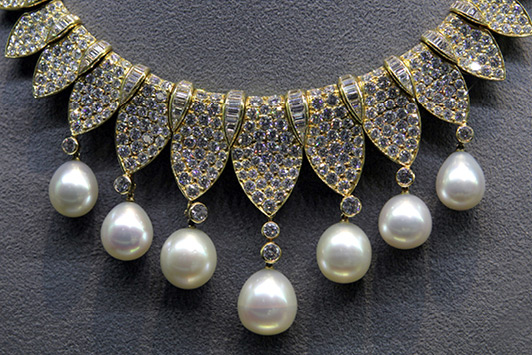
For Las Vegas jewelry week this year, several jewelry, gem and watch trade fairs shared space in one wing of the massive Las Vegas Convention Center (LVCC). One of those was the 23-year-old Las Vegas Antique Jewelry & Watch Show, which hosted 425 exhibitors. Even with the multiple fairs present, the vastness of the hall may have given the impression that there was little activity, which was far from accurate.
Most exhibitors seemed happy with the business they were getting, saying it was equal to or better than that of past years. Still, traffic wasn’t always steady. Although the show enjoyed a strong opening when it kicked off on May 30, it slowed a bit after the nearby JCK Las Vegas fair opened the next day, according to Guy Attia, president of Jewelry World in Aventura, Florida.
Gem dealer Jeffrey Bilgore affirmed the crowds were coming in spurts. He was exhibiting at the American Gem Trade Association (AGTA) GemFair, which sat across from the antique dealers at the LVCC. Indeed, he noted, the two groups were carrying on trade with one another, as their wares were compatible.
Auction reflections
As expected, signed jewels and period pieces were popular at the show. Vendors that sold contemporary jewels also did well. Rare items and those with low price points moved, but there was a lack
of interest in mid-range items.
In other words, the trends pretty much mirrored the auction market.
Big names were the main sellers, according to exhibitors. Cartier and Van Cleef & Arpels were the most in demand in the already sought-after signed-jewelry category.
“Signed jewels have residual value,” said Steve Neckman, owner of dealer Steven Neckman in Miami, Florida. “If you buy signed jewels, you’re pretty much guaranteed to get your money back.”
Colored gems were popular as well, reported Amy Rothner of Excalibur, an estate jeweler based in Los Angeles, California. “Lots of color and yellow gold
have been selling. A lot of people are looking for things to repurpose.”
Marianne Fisher of New York-based estate dealer Paul Fisher said the contemporary jewelers that her store stocked were selling nicely, including JAR, Wallace Chan and Hemmerle. In terms of gems, she pointed to pink and blue diamonds, as well as padparadscha and Kashmir sapphires.
Modern marvels
With the 21st century about to enter its third decade, collectors are starting to appreciate the historical perspective of jewels from the latter half of the 20th. Mid-century jewels are one of the specialties of Burns Estate Jewelry in Blue Ridge, Georgia, and business from this period has been strong, according to co-owner Sara Burns.
“We’re seeing demand for big, bold pieces from the 1960s, ’70s and ’80s, particularly from David Webb and Tiffany,” she said.
Burns isn’t alone; auction houses and galleries have been promoting jewels from this era of late. Fashion designers Marc Jacobs and Miuccia Prada, for instance, collect pieces by Andrew Grima, the London jeweler whose works in the 1960s and ’70s adorned Britain’s Queen Elizabeth II and former US First Lady Jackie Kennedy Onassis. In 2017, Bonhams
London held an auction of 55 Grima jewels, and they
sold out, fetching $1.1 million.
Burns is particularly bullish when it comes to David Webb, asserting that Mark Emanuel and Robert Sadian — who purchased the brand about nine years ago — have created renewed interest. “They are doing a great job,” she declared. “We love the product, and it always sells well.”
Concerns for the future
While jewelry suppliers were satisfied with business at the show, there was a sense of anxiety about the future of the antique market. Their worries centered around four issues: digital media, disinterested younger consumers, cultural changes among wealthy consumers, and global uncertainty.
“Jewelry has become an accessory. There isn’t a sense of sentimentality attached to it anymore,” Neckman lamented.
“I think the internet has created the illusion that everything is accessible,” added Tracy Zebrak, whose firm specializes in rare historical art pieces. “You have to hunt the world for these treasures.” She also observed that “people don’t want to display their wealth anymore.”
Nonetheless, Zebrak continues to pursue the aforementioned treasures. “I have a great belief in what we do. Jewelry is art.”
Image:Las Vegas Antique Jewelry & Watch ShowArticle from the Rapaport Magazine - August 2019. To subscribe click here.